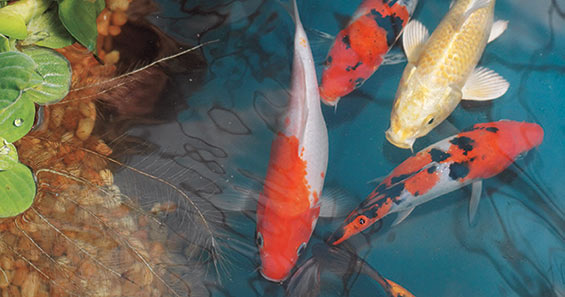
Virtually unknown to the west until after the 1950's, koi seem to be as integral to contemporary water gardening as cattails and water lillies. Their stunning coloration, playful personalities and gliding tranquility can transform a backyard pond into a personal paradise. However, consider these important tips:
Adequate Water Volume and Filtration
The most important factors to consider are whether your pond is big enough and has sufficient
filtration to support a healthy ecosystem for koi. The ideal koi pond will be larger than 1,000 gallons with a filtration system that re-circulates the entire volume at least twice an hour (2,000 gph).
Stocking Suggestions
Start out small, sparse, and inexpensive, following the general rule of 1 inch of fish per every square foot of water surface, remembering that 2"-4" koi will reach 30" long in no time. The more fish you add, the more filtration you'll need to keep ammonia and nitrite levels in check, so populate slowly and feed sparingly until you're confident you can maintain life-supporting conditions in your pond.
Provide Safe Zones
Koi will fare better if you provide areas that are deeper and shadier to offer refuge from summer heat and shoreline predators. To thwart hungry paws hunting from shore, your pond's edge should drop off sharply at least 8" to keep your precious ones out of reach. And while planting lilies will provide them shade from soaring temperatures, bottom-foraging koi are notorious for uprooting any planting baskets you haven't anchored down with rocks!
Splashing, Tumbling, or Bubbling...
Where there's water agitation, there's air mixing with water to replenish vital oxygen levels in your pond. Without a fountain,
aerator, or
waterfall to oxygenate the water, your fish are at risk of suffocation, especially in hot weather or if your filters fail.
Be Prepared for Emergencies
Every experienced koi enthusiast keeps a
fish net and quarantine pool on hand. Isolate and observe any new arrivals for a minimum of two weeks until you're sure they're not going to introduce illness to a healthy pond.
In the long run, your key for fish-keeping success is education, conversation with other enthusiasts, and diligent attention to a healthy maintenance schedule. The care you provide will be rewarded with
graceful koi for decades!
| IMPROVEMENT IDEAS |
A pinch of salt for good health
What's the secret to keeping healthy koi? A dash of pond salt! Adding
pond salt in proper doses will help boost your koi's natural defenses to disease, stress, and nitrite toxicity. It is also a natural way to kill any parasites lurking in your pond. First, salt acts to stimulate the stress coat, thickening the natural slime barrier which serves as a shield against disease. Second, the mineral-rich tonic supports healthy gill function by providing essential electrolytes with every breath, reducing the risk of stress-induced osmotic shock and even temporarily blocking the toxic effects of nitrite. |
|



